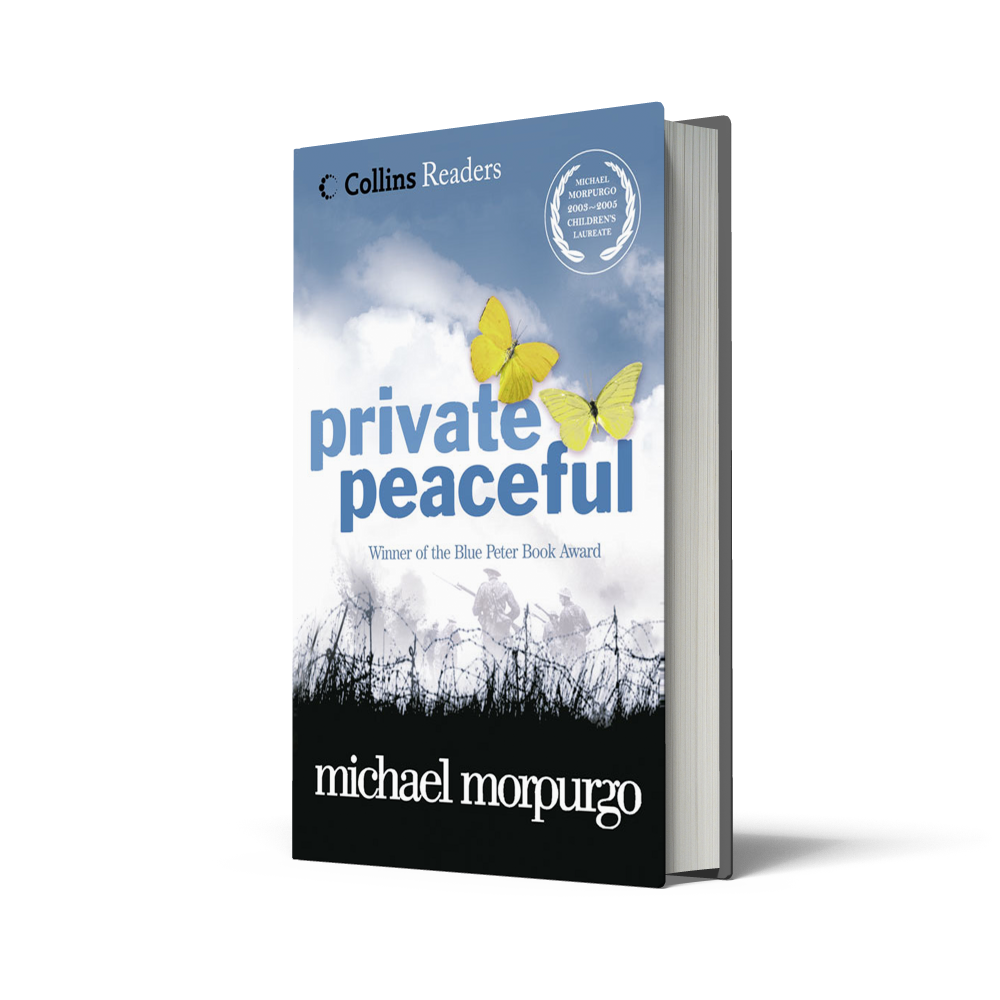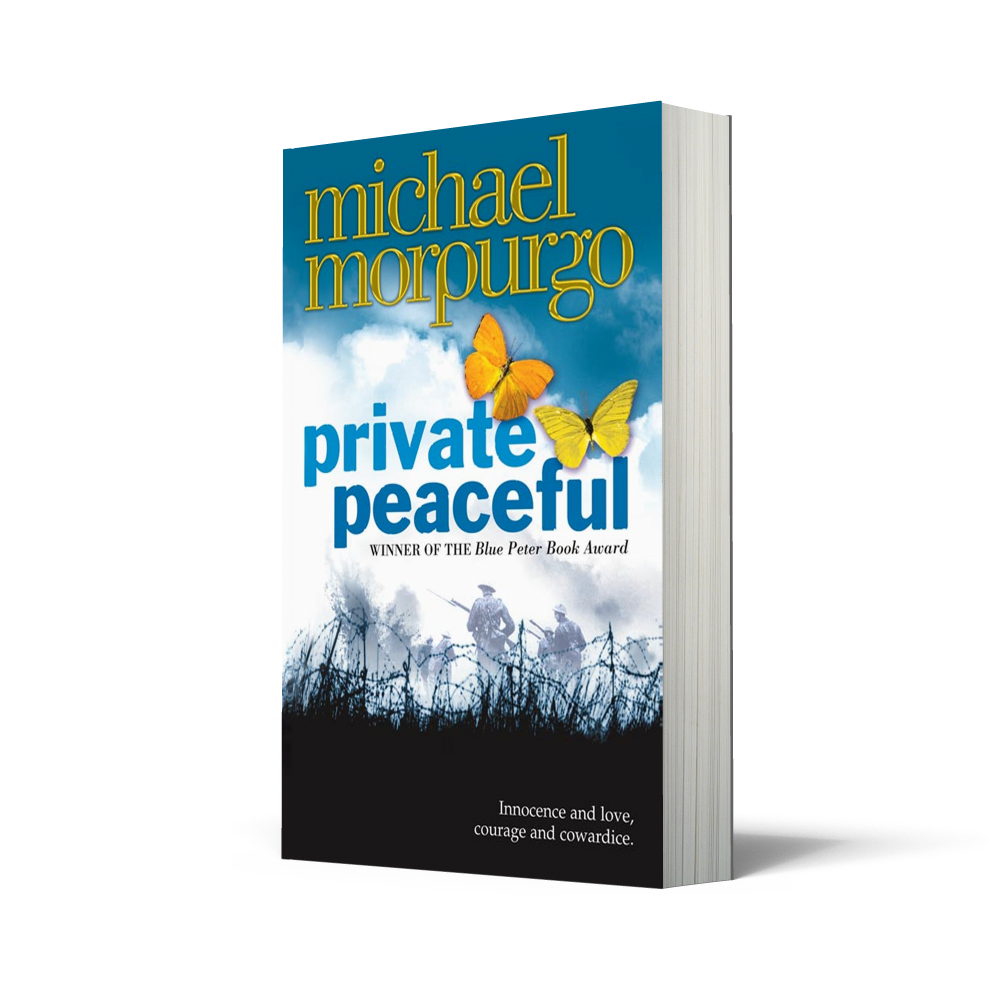The art of using great writing to form children’s minds has become a little lost in that of plundering extracts for literacy objectives. Michael Morpurgo’s Private Peaceful certainly achieves the former Children’s Laureate’s aim of putting ‘literature back into literacy’ and, when taken as a whole, has an educational value greater than the sum of its literary, linguistic and literacy parts. This book’s ‘whole’ also has latent within it a vast array of potential adaptations, adding to its wealth for use in the classroom.
The book is a chronological flashback of a fondly remembered (idyllic but never sentimentalised) Devon childhood framed by a ‘present’ – a night time vigil in the trenches. This vigil is briefly evoked at the beginning of each chapter, and counted down by a timepiece – via chapter titles – to a dawn execution of the narrator’s beloved older brother. The gradual ‘reveal’ of this situation is very satisfying for the reader, and the prepared, emotionally profound climax is also the resolution (so much for totalitarian prescriptions for ‘whole texts’!). This inventive structure lends itself to dramatic interpretation on both stage and screen.
 Simon Read’s one-man stage play stays close to the book’s narrative method (monologue) and medium (the word). It “plays a theatrical conjuring trick, summoning the world of the story in the mind’s eye of the audience. Everything is seen from Tommo’s perspective. He conjures all this up in these last hours before the firing squad at dawn, creates everything before our very eyes. This play-acting you can imagine somebody doing in their own bedroom: tipping their bed over and saying, ‘now this is a trench’, or being one moment at home and the next in the middle of a market square, simply by articulating it. It’s non-literal theatre and children have the imagination to make that leap.” His imaginative dramatic process makes both literary content and form hands-on clear for students here. It enacts how written fiction – words – evokes a world. “There’s a magical alchemy in theatre where you get excited by the artifice of it. You get transported on extraordinary journeys of the imagination with very few tricks, by the power of the word.” Children learn from play and this is serious educational play, only with treats like the way the partly revealed prison bed can become the grid of a prison window. It tackles grim adult realities like war and death using child-play, reminding us how close these soldiers were to childhood. It brings the audience literally face to face with loss, fear, loneliness, homesickness. Actors (our students) can speak the words, act the moves, by which such emotions are created. A play can in this way physically and personally focus on how a character experiences his or her part in it.
Simon Read’s one-man stage play stays close to the book’s narrative method (monologue) and medium (the word). It “plays a theatrical conjuring trick, summoning the world of the story in the mind’s eye of the audience. Everything is seen from Tommo’s perspective. He conjures all this up in these last hours before the firing squad at dawn, creates everything before our very eyes. This play-acting you can imagine somebody doing in their own bedroom: tipping their bed over and saying, ‘now this is a trench’, or being one moment at home and the next in the middle of a market square, simply by articulating it. It’s non-literal theatre and children have the imagination to make that leap.” His imaginative dramatic process makes both literary content and form hands-on clear for students here. It enacts how written fiction – words – evokes a world. “There’s a magical alchemy in theatre where you get excited by the artifice of it. You get transported on extraordinary journeys of the imagination with very few tricks, by the power of the word.” Children learn from play and this is serious educational play, only with treats like the way the partly revealed prison bed can become the grid of a prison window. It tackles grim adult realities like war and death using child-play, reminding us how close these soldiers were to childhood. It brings the audience literally face to face with loss, fear, loneliness, homesickness. Actors (our students) can speak the words, act the moves, by which such emotions are created. A play can in this way physically and personally focus on how a character experiences his or her part in it.
Simon Reade’s filmscript gives us a different perspective again. “When writing the screenplay for the movie, the whole story became more literal, visualised not in our imagination, but seared into our iris by the moving picture.” Film dramatisation enables director and audience to widen their understanding of characters. In the book, ‘mother’ is enough. In the film, she is named (Hazel, “a countryside kind of name, elegant yet earthbound”) and given a race to show and celebrate her character. Scenes are added outside the narrator’s ken – like Charlie’s love scenes (and a dance) with Molly – or which show his isolation – like working alone. An Empire Day village fete; tug of war; colonel-wife-Wolfwoman business and a shoot are all added to make explicit what the novel implies: a larger community set for a violent end (the First World War: a shoot on a larger scale). Tommo’s wider world is shown: the one hand, a predatory class – “my land, my pheasants”, where wives and gamekeepers are callously replaced – on the other, ardent working class maternity and brotherhood, and young lives. The film can articulate and analyse wider social and economic contexts which Tommo the narrator senses and experiences on a personal level.
In reading a novel with students, we as teachers are facilitating a learning method older than Homer: wise author engaging directly with child. In play dramatisation, guided by the author’s words, we “primarily embrace the story-telling vision of the actor” and, in film, of “the director, producers, leading actors, and Morpurgo himself.” (Though it is always easier to make a great play or film if you have a great book to base it on.) The outcome of a lesson that looks at the whole world of Private Peaceful is learning what each form uniquely gives the learner.
All quotations from Simon Reade’s article, How I adapted Private Peaceful for the stage and screen – in pictures, and used with permission from the author.
Download free teaching resources:
1. Private Peaceful_Classroom Activities
2. Worksheet_Example dramatisation of Five to Five_Private Peaceful
3. Worksheet_Students’ own dramatisation of Nearly Five To One_Private Peaceful
Gareth Calway retired as a comprehensive school Head of English and Media Studies in 2007 to write full time. He has published seven volumes of poetry and a schooldays novel; taken several one man shows to the Edinburgh Fringe, acted in corporate and other movies; has a residency at Oliver Cromwell House in Ely with his dramatic monologue ‘Cromwell’s Talking Head’ and is actor manager of Room at the Gin Theatre Company. Collins published his children’s novel about the slave trade ‘Bound for Jamaica’ in 2012 and a second edition of his best-selling KS3 series ‘Aiming For Progress’ – which he wrote and/or edited – in 2013. He is a feature writer and reviewer for the ‘Eastern Daily Press’, ‘Suffolk Norfolk Life’ and the ‘Lynn News’. He is currently writing a children’s novel about the English Civil War and an adult one about Sir Robert Walpole and ‘Turnip’ Townshend. Other workshops, resources, poems and scripts are available free at www.garethcalway.co.uk
{photo by John Hedgecoe}




